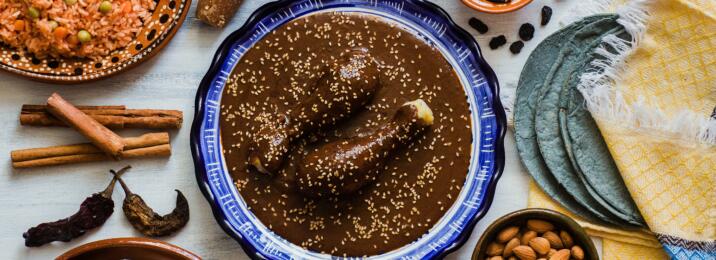The Art of Mole: Unraveling the Complex Flavors of Mexico’s Signature Sauce
Only a few dishes come out as emblematic and revered as mole sauce in Mexican cuisine. With its rich history, diverse flavors, and complex preparation, mole embodies the essence of the country’s culinary tradition. In this exploration, we’ll dive into the details of the mole sauce, uncovering its origins, ingredients, variations, and the secrets to mastering this beloved ingredient.
What is Mole Sauce?
Mole, pronounced “MOH-leh,” is a rich, velvety sauce originating from Mexico. According to the Nahuatl Dictionary, its name is derived from the word “molli,” meaning mixture, sauce, or concoction. Mole is characterized by its deep, complex flavors, often achieved through the combination of various ingredients, including chili peppers, chocolate, nuts, seeds, spices, and sometimes fruits.
In traditional Mexican cuisine, this sauce can also be used as a marinade. The term sometimes refers to a variety of sauces and marinades in contemporary cuisine, with some variants even being quite dissimilar to others.
When you ask local Mexicans, they may refer to any of the following as types of mole sauce:
- mole rojo (red mole)
- mole almendrado (mole with almond)
- mole chichilo
- mole pipián (mole with squash seed)
- mole verde (green mole)
- mole amarillo or amarillito (yellow mole)
- mole poblano (this is regarded as one of the most popular versions of mole)
- mole michoacan
- mole ranchero
- mole manchamantel or manchamanteles (tablecloth stainer)
- mole colorado or coloradito (reddish mole)
- mole tamaulipeco
- mole prieto
- mole xiqueno
- mole rosa (pink mole)
- mole blanco (white mole)
- chimole
- guacamole (mole with avocado)
- huaxmole (mole with huaje)
Heritage and History
As you learn how to use mole sauce, you inadvertently also learn about its rich history and cultural heritage. Even though some states in Mexico claim to be the origin of the traditional mole sauce, such as Oaxaca and Puebla, it can be argued that the recipe itself has been around for much longer.
The roots of mole sauce can be traced back centuries to pre-Columbian Mexico, where indigenous civilizations such as the Aztecs and the Maya utilized various native ingredients. Mole likely evolved from traditional indigenous sauces, often made by grinding ingredients like chili peppers, tomatoes, and herbs.
Over time, mole became intertwined with Mexican identity and culture, evolving into a symbol of celebration and community. Today, the traditional mole sauce is an integral part of Mexican cuisine, with each region boasting its unique variation of the sauce, passed down through generations.
Ingredients and Flavors
To learn how to use mole sauce, you must master its various ingredients and flavors. One of the most intriguing aspects of mole is that its flavors can vary dramatically depending on the ingredients used and where the sauce variant was made. While there are countless variations of mole, some common ingredients include:
- Chili Peppers: Whether dried or fresh, chili peppers form the base of most mole sauces, providing heat and depth of flavor. Common varieties include ancho, pasilla, and chipotle peppers.
- Chocolate: A defining element of many mole sauces, chocolate adds richness and complexity, balancing the heat of the chili peppers with its subtle sweetness.
- Nuts and Seeds: Ingredients like almonds, peanuts, sesame seeds, and pumpkin seeds are often toasted and ground to add texture and nuttiness to the sauce.
- Spices and Herbs: Cinnamon, cloves, cumin, oregano, and cilantro are just a few of the spices and herbs that contribute to the intricate flavor profile of mole.
- Fruits: Some mole recipes incorporate fruits such as plantains, raisins, or tomatoes, adding a hint of sweetness and acidity to the sauce.
You will experiment with different ingredients as you learn about the other variants. Exploring how each new ingredient impacts the sauce’s flavor can be an enjoyable culinary adventure.
Different Types of Mole Sauce
There are countless variations of mole sauce, but a few notable types include the following:
- Mole Poblano: Perhaps the most famous type of mole, mole poblano hails from Puebla and is known for its rich, chocolate-infused sauce. It is typically served over poultry, such as chicken or turkey.
- Mole Negro: Originating from the state of Oaxaca, mole negro is characterized by its dark, smoky flavor, achieved through the use of charred chili peppers and spices. It is often served with chicken or pork.
- Mole Verde: Made with fresh green herbs and chili peppers, mole verde has a vibrant, herbaceous flavor profile. It is commonly served with pork or enchiladas.
What Does Mole Go Well With?
Mole sauce is incredibly versatile and can be paired with various dishes. Some classic combinations include:
- Chicken: Mole poblano is traditionally served over chicken, creating a harmonious balance of flavors and textures.
- Enchiladas: Mole sauce adds depth and richness to cheese or chicken enchiladas, elevating this classic Mexican dish.
- Tamales: Mole tamales are a popular choice for special occasions, with the sauce infusing the masa dough with its complex flavors.
- Vegetables: Mole sauce can be drizzled over roasted vegetables or used as a dipping sauce for chips or crudites, adding depth to vegetarian dishes.
Feel free to experiment by pairing mole sauce with various dishes. You may discover some new twists as you go along the way.
Experience The Various Mole Blends at Benito’s Restaurant
With its rich history, diverse flavors, and intricate preparation, the mole sauce embodies the best in Mexican cuisine. It celebrates the vibrant tapestry of flavors and ingredients that define the country’s culinary heritage.
Benito’s Restaurant has proudly served authentic Mexican dishes since 1981. Experience the different flavors of mole sauce when you try our meals. Book now and enjoy the traditional Mexican recipes today.






